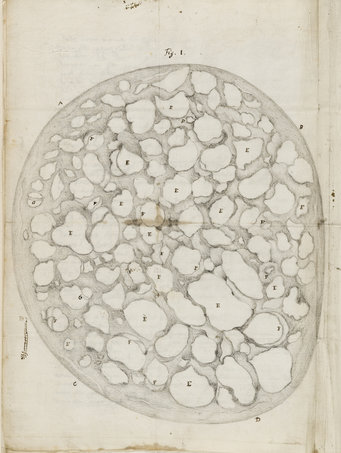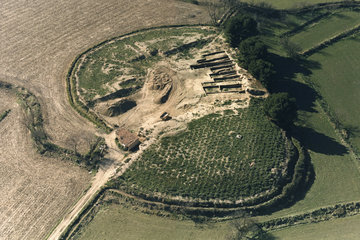Eye to eye with a 350-year old cow
Leeuwenhoek's specimens and original microscope reunited in historic photoshoot
What may be the earliest surviving objects seen by microscope – specimens prepared and viewed by the early Dutch naturalist Antoni van Leeuwenhoek – have been reunited with one of his original microscopes for a state of the art photoshoot. This event allowed science historians to recapture the 'look' of seventeenth century science, recording the moment in digital films and with stunning high-resolution colour photographs for the first time.

Delft-based naturalist Antoni van Leeuwenhoek was one of the first generation of serious microscope users, famous for his high-powered single-lens instrument that enabled him to see the natural world down to the scale of some large bacteria. As evidence for his 1670s and 1680s observations, narrated in letters to the London's Royal Society, he sent a variety of specimens: cows' optic nerves, sections of cork and elder, and 'dried phlegm from a barrel'.
In September 2019, these materials, in their original packages, flew back across the North Sea from the Royal Society to Leiden and the Rijksmuseum Boerhaave—the Dutch national museum of the history of science and medicine–where they were reunited with an original Leeuwenhoek microscope. The museum provided the opportunity for taking photographs through the original microscope, as well as the shooting of moving images.

Science and art historian Sietske Fransen, now Leader of the Max Planck Research Group 'Visualizing Science in Media Revolutions' at the Bibliotheca Hertziana - Max Planck Institute for Art History orchestrated the event. She conducted readings of Leeuwenhoek's letters, while photographer Wim van Egmond and Rijksmuseum Boerhaave curator Tiemen Cocquyt were entrusted with the exceedingly delicate operation of filming through the priceless original silver microscope. In combining words and images, the team hope to arrive at a better understanding of Leeuwenhoek's groundbreaking observations and his use of artists to capture microscope views.
Professor Sachiko Kusukawa is the Principle Investigator of 'Making Visible', a four-year project based at the University of Cambridge dedicated to understanding the illustrative practices of the early Royal Society. She said of the photoshoot: "This event is a result of a network of scholars brought together by the 'Making Visible' project, an interdisciplinary research project supported by the Arts and Humanities Research Council of the United Kingdom. It shows what can be achieved through true European collaboration, thanks to the Royal Society, Rijksmuseum Boerhaave, the University of Cambridge (CRASSH) and the Bibliotheca Hertziana – Max Planck Institute for Art History."
Although Leeuwenhoek's specimens have been imaged before, this is the first time that the latest digital techniques have been applied to the surviving specimens. Each item was recorded with still images before being filmed with a modern camera, through an original Leeuwenhoek microscope. These moving images allow researchers to replicate the changing light conditions and specimen orientation that were possible while using one of Leeuwenhoek's own hand-held devices. It is the closest recreation to date of Leeuwenhoek’s working conditions.

Antoni van Leeuwenhoek (1632-1723) was born in Delft, Netherlands, where he lived and worked. His interest in lens-making may have been spurred by his connection with the textile trade. He became adept at hand-crafting single lens microscopes. In these small instruments, the lens was held within silver or brass plates. Specimens were manipulated using an ingenious pin and screw arrangement: brought close to the eye they proved to be a powerful research tool. Very few Leeuwenhoek microscopes survive and today, they are among the treasures of Early Modern science in European museums.
Leeuwenhoek sent his many observations to the Royal Society in London, for publication in the journal Philosophical Transactions. Although the written descriptions were Leeuwenhoek's own, he collaborated with artists to capture what he was seeing in original drawings, which were engraved for wider dissemination. In a fifty-year period from the 1670s to the 1720s, Leeuwenhoek became the first, or one of the first, to see many aspects of life: he described 'animalcules' (micro-organisms such as rotifers), human and animal spermatozoa and investigated the structure of plants. Leeuwenhoek became a Fellow of the Royal Society in 1680.
Rijksmuseum Boerhaave is the national museum of the history of science and medicine in the Netherlands and one of the most important scientific and medical history collections in the world, home to four of the 11 remaining original Leeuwenhoek microscopes.














